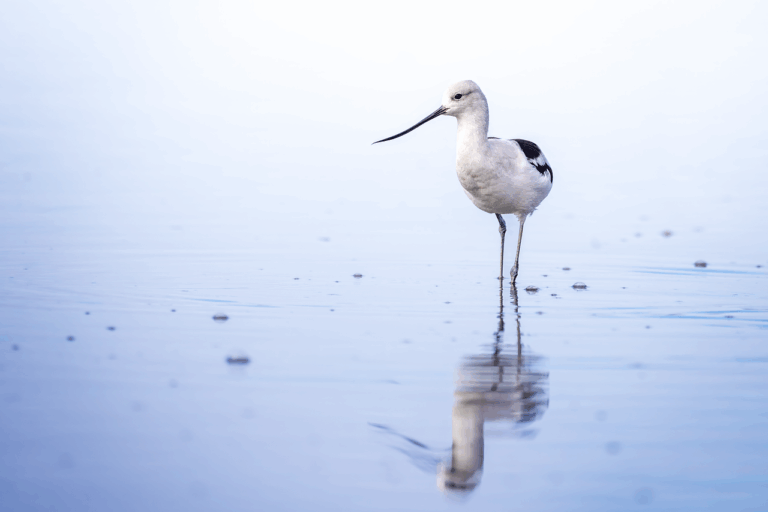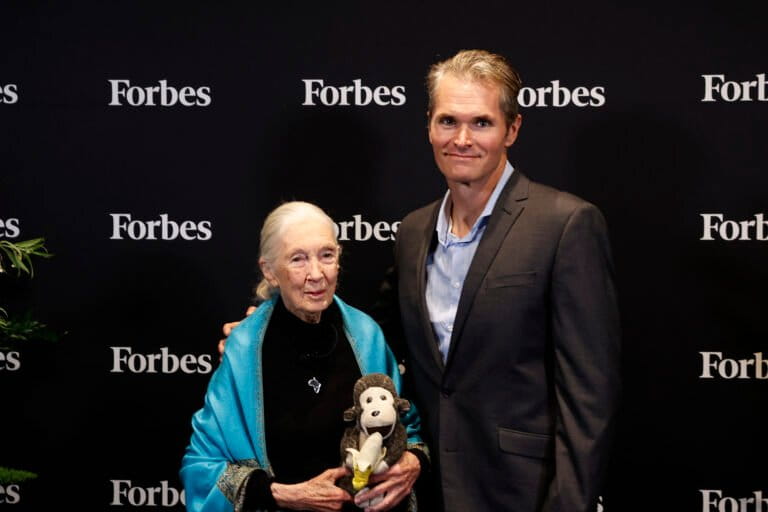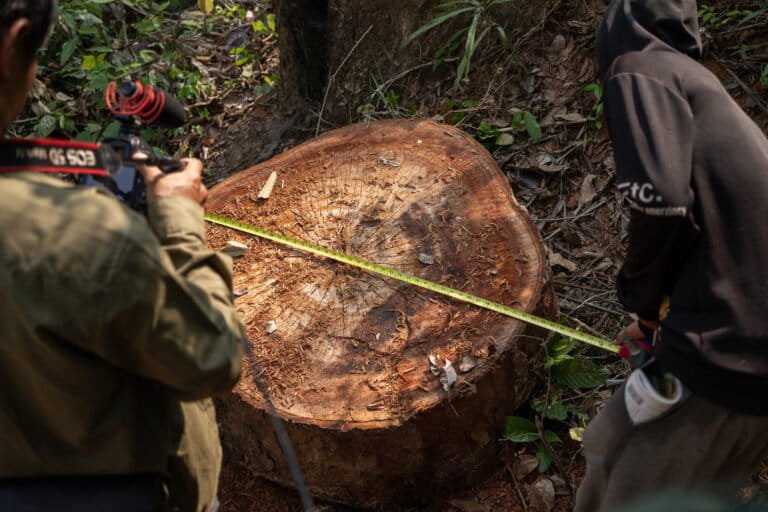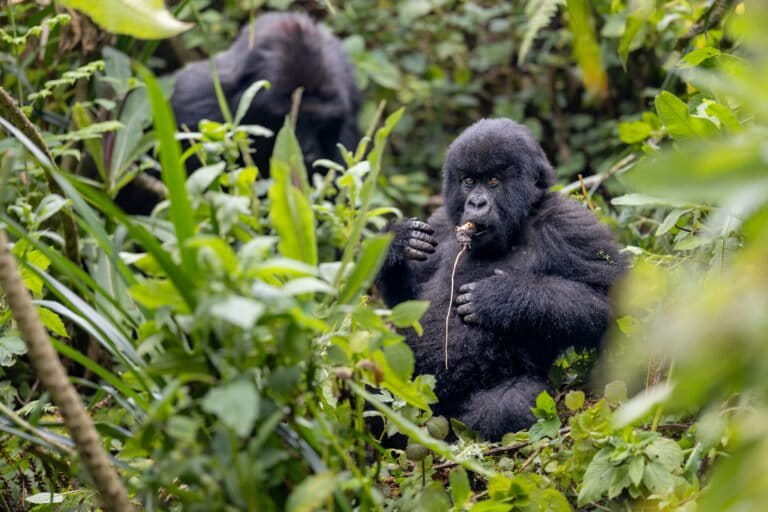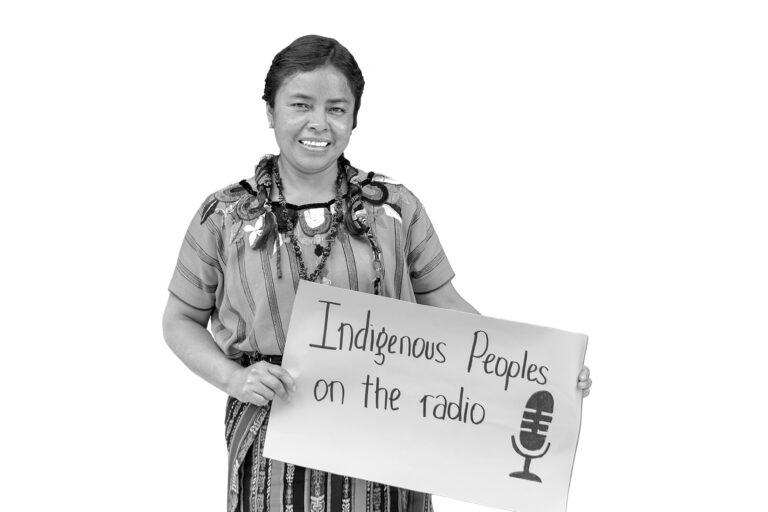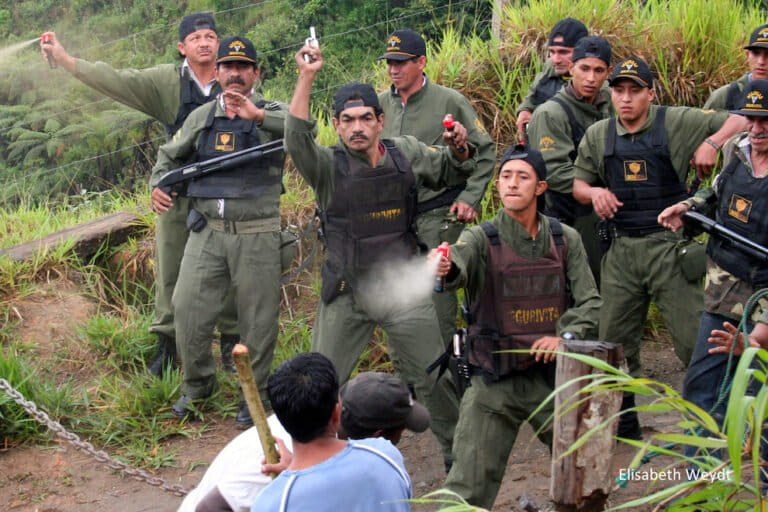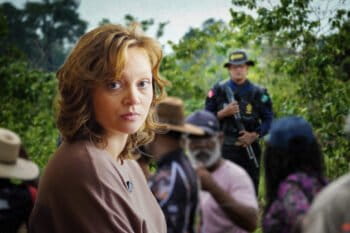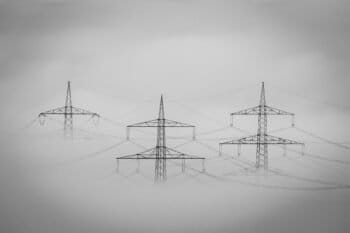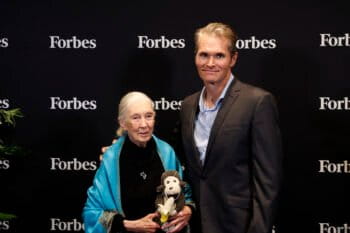Wildlife biologist and ornithologist Corina Newsome of the U.S. NGO National Wildlife Federation joins Mongabay’s podcast to discuss how bird-watching plays a role in environmental justice for underserved communities in urban areas, and provides an accessible way for people to connect with nature and drives impactful change.
“Birding is an opportunity [for] people to fill in data gaps where they live [to] help direct investments that come from the world of conservation … from federal to state to local levels that have usually been funneled away from their communities,” she says on this episode.
Newsome is also a co-founder of an annual event called Black Birders Week, and says that birding changed her life. She’s hopeful it can also change the world, because bird health has direct implications for biodiversity health at large.
“ What birds require of us will benefit us in ways that are far beyond bird conservation. We can work together to solve problems and think about the ecological emergency and environmental harms are taking place across landscapes, across boundaries,” she says.
Newsome also encourages younger people and scientists to run for office at the federal, state and local levels in the United States. She says coordination and basic understanding of environmental justice are lacking, and urges people to visit runforsomething.net.
“There are teenagers who would do better at writing legislation than some of the elected officials in Congress right now,” she says. “They need social scientists in there. They need scientists working in Congress. They need scientists running for office.”
Find the Mongabay Newscast wherever you listen to podcasts, from Apple to Spotify. All past episodes are also listed here at the Mongabay website.
Mike DiGirolamo is a host & associate producer for Mongabay based in Sydney. He co-hosts and edits the Mongabay Newscast. Find him on LinkedIn and Bluesky.
Banner image: American avocet. Image by Michael Barry via Pixabay (Pixabay Content License).
Related listening:
See also: On Mongabay’s podcast in 2020, biologist & Black Birders Week co-founder Earyn McGee shared how the event came together so quickly, and why it’s necessary to celebrate black nature lovers, listen here:
Transcript
Notice: Transcripts are machine and human generated and lightly edited for accuracy. They may contain errors.Corina Newsome: Birds, they’re connectors. They connect urban areas and rural areas. They connect regions, countries, hemispheres, right? To successfully conserve birds requires coordination across boundaries that we may not be currently or historically set up to be really coordinated with it. It requires collaboration. It requires being synergized, right? And so what birds require of us will benefit us in ways that are far beyond bird conservation. We can work together to solve problems and think about. Ecological emergency and environmental harms are taking place across landscapes, across boundaries like it. It sets us up to just be better problem solvers for people and the ecosystems that we share.
Mike DiGirolamo: Welcome to the Mongabay Newscast. I’m your co-host, Mike DiGirolamo, bring you weekly conversations with. Experts, authors, scientists and activists working on the front lines of conservation, shining a light on some of the most pressing issues facing our planet and holding people in power to account. This podcast is edited on Gadigal land today. On the newscast we speak with Corina Newsome, a wildlife biologist, or neologist in science communicator. She talks to me about an increasingly popular hobby birdwatching, but more than simply a hobby Birding. As Newsom describes, it is a way for people from all walks of life to connect with the natural world, but the connection goes deeper. Birding, Newsome says, plays a critical role in promoting racial and social justice for communities in urban ecosystems. Whether they are historically underserved, such as black and brown communities or low income communities, birding has helped fill the gaps in both data collection and the perception of these communities. She also describes to me how the bureaucratic quagmire of federal agencies are failing to address environmental justice issues in cities and why more young people should run for these offices. If you’re like me and you’re someone who lives in a city, this is a podcast conversation you have got to listen to all the way through. As Newsome describes how you can become more involved in the decision making and policy processes for citywide ecosystems, which as she notes have ripple effects for biodiversity at large. Cities are pretty close to my heart, and I agree with Newsom that the perception that they are a devoid of wildlife is a harmful one, and hopefully one that is beginning to shift. Corina Newsome, welcome to the Mongabay newscast. It’s a pleasure to have you with us.
Corina: Thank you so much. It’s an honor to be here. Thank you.
Mike: so for folks that don’t know who you are, can you please give them a brief history of the work you do and, why?
Corina: Yeah. I’m a wildlife biologist and I’ve worked in several capacities in the field of conservation. I started out as a zookeeper actually, primarily focused on, on bird conservation and bird care and education and outreach. and then I went back to school to study C birds on the coast of Georgia, where I was deep in the salt marsh. I’m a city girl, so I was not used to it. and that was like my full immersion into the world of wildlife biology. And since then I’ve really worked at the intersection. Wildlife Science and management, and policy. And I’ve come to learn a lot more about policy in recent years in my work at National Wildlife Federation. and central to all that work, though, the thing that roots it, that the thing that I’m rooted in and it binds it all together, is how can we solve problems for people at wildlife? How can we, advance a wildlife conservation movement that it also advances environmental justice for people, for human communities.
Mike: That sounds like great work, and we’re gonna dive into that a little bit more, but our main focus today is talking about birding, which you’re, quite passionate about. And I read on your blog that you mentioned that birds changed your life. so how has birding changed your life?
Corina: I think birds were so fascinating to me because I’ve always known I wanted to study animals, wildlife from the time I was like four very young. and all the way up through me getting my actual undergraduate degree in, in wildlife biology, loved wildlife. But it wasn’t until I took Ornithology, which was a required class, all about birds and bird biology. Then I realized I was missing the entire world of birds around me. And when I took my first class in a semester for ornithology and I learned about the blue jay, which is my spark bird, which means it’s the bird that got me paying attention to all other birds. I was surprised that me, a wildlife enthusiast could have missed out on the literal abundance of birds that were around me every single day. And it made me realize, wow, if I’m a wildlife biologist and I had no idea how abundant and diverse and incredible birds are, I can’t imagine what others who are like me from a city. I’m from Philadelphia originally. didn’t grow up around a whole bunch of wildlife. I wonder what other folks like me are experiencing or might be missing. and so birds changed my life in particular because it allowed me, it opened up my world in such a way that allowed me to see life and get births of encouragement and joy and, getting refreshed even when I wasn’t really looking for it. If I’m outside or if I can hear outside or see outside, if a bird crosses my field of vu. Immediate injection of joy, immediate like excitement. And to be able to have access to that anywhere is a real gift. And so I want other people to experience that gift too. And so I can say with confidence that the people who have come on board with birding with me, my friends, my family, like they have had, had that joy become infected in them too. And so birds just do that to people. And I’m just very lucky that they did that to me.
Mike: Yeah, I hadn’t heard the term spark bird before. That’s really, that’s a really good term because it allows people to be like, that’s, that was my first one. That’s what got me hooked, right?
Corina: That’s why we use It, it didn’t ignites the birding fire in us.
Mike: Yeah. For me, that would be the IBUs, here in Sydney. That’s the one that got me really interested in birds because it’s really ubiquitous here. it’s very intelligent. but got me super interested in birds. but in a way, I think what you’ve just started to touch upon is that birding, or at least looking at a bird, even if you aren’t like a bird watcher per se, just observing that wildlife immediately plugs you into the fact that there’s an entire living, breathing ecosystem around you. Would you agree with that and what does, what do you think that does to a person?
Corina: Yes. And I’m glad you bring that up because that’s exactly the frame that I use when I’m talking to a lot of young folks who are from places like me. Every year, I’ve had the privilege of, for the past several years working with an organization called The Fund two Foundation, which brings black youth from all over the country up to Colorado, around the mountains and the way I bring birding to them. And they can hopefully take it back to where they’re from and the discussions that we have and the way that we think about what birds do for us and what they allow us to realize is that. Because there’s, they’re everywhere. Because there’s really nowhere you can go where you’re not gonna see a bird of some kind. And pigeons count, by the way, no matter where you are. Yeah. But it allows you to recognize that the decisions you make, that impact the natural resources, the living world where you are, doesn’t matter if you’re in the middle of the city or if you’re in the middle of the rural area, that it matters and there is something else alive that will immediately reap the benefits or the repercussions. Of the decisions that we make. and so it allows people to be conscious in a way that’s reinforced over and over again. Once you start learning and noticing the, this, abundance of life that’s outside and right around you, it’s it’s a constant reminder of, wow, how am I stewarding the place where I am? And even if you’re a kid, even if you’re not someone who has control per se, on how the, yards or the city is managing the city parks, right? You may not have control in that way, but it keys you in. and the places where you do have control, the places where you do have choice, you start to be conscious. And then when you grow into an adult, no matter what career path you take, if you’re in cosmetology, if you’re a surgeon, if you’re a lawyer, if you’re a scientist, there are ways that you can be good stewards of the living world that we’re in, no matter what you do. And birds are a beautiful reminder every single day, all day of why it matters.
Mike: I’m curious to, to hear from you, if you notice a before and after with the people that you work with, especially youth. what is the, is there like a, a reflection or process that takes place that you notice?
Corina: I’ve been grateful to, to witness this in a few scenarios where. if they’re young folks who I have the privilege of keeping in contact with somehow, like over the course of their development and their careers, I tell you, my phone is full of texts. Sometimes from the kids, miss Corina, I saw, what’s this bird? Send me a picture. Or, next, time I see them, we have this bird, in our yard. It’s and it doesn’t, it’s not just the youth, even the elders, like my aunties and uncles, like the older folks in my life, like in my community, sending me text messages, voice notes, with you’re not gonna believe what I heard today. And it just, it’s always a reminder for me and encouraging to me to see, yes, what happened to me happens to so many other people. When you start paying attention to birds. It doesn’t stop at birds, which I think is awesome because once you start paying attention to birds, you start paying attention to where they are, what they eat, what they do, how they live, which like necessarily makes you pay attention to the larger ecosystem and context that you’re in and that those birds are in, which we all need to do much more of.
Mike: Yeah. I think it’s worthwhile for us to pause and, ask this question, which we’ve probably already answered a little bit, but, Why birding and why not Maming? Christian Cooper posed that in his book, better Living Through Birding. he was asking the question, if we’re, like, looking at animals like we like, like almost like a collection as of sorts, why are we choosing birding? And his sort of argument or conclusion that he came to was that there is a greater variety of birds than mammals in any given location and therefore it’s more accessible, for people to connect with. So what. What are your thoughts there? Do, do you agree with Christian’s sort of take on that or do you have anything to add to it?
Corina: Yes, absolutely. So I 100% agree and one of the reasons why I love birds is because of how accessible they, they are geographically along the urban to rural gradient. and even with like your senses, like if you maybe can’t see them very well or if you dunno how to use binoculars, you can hear them and if you can’t hear them, you might be able to see them. There are just different ways to experience birds. I also encourage Bamming. So because I’m a wildlife biologist and I’ve been very lucky to have an education that kind of covers all taxonomic, major taxonomic groups, like in the US If I can, I’m gonna be pointing out the mammals. I’m also gonna be pointing out the insects, even the ones that scare me and my city sensibilities, right? Like I, I try to allow birds to be a springboard. And so birds are a good place to get hooked on. And if you stay there, that’s excellent. But I’m gonna try to point you in a couple other directions too, if I can.
Mike: What would you say is like a contender for the next step or. if like birding is like the gateway, what’s like the next animal where you would go, okay, now you need to graduate to this one. What would you say that would be? It?
Corina: It depends on where people are, but I would actually say herping, which is reptiles and amphibians out here where I am in Atlanta, Georgia, in the southeast US we have a real beautiful abundance of salamanders and frogs and lizards and so that’s the next thing because, and snakes, oh my goodness. I noticed that. People interact with these animals a lot. And and they oftentimes cause a lot of fear. And so the next step that I try to take people to is why this snake in your yard is very cool and very important, right? Yeah. Or why this lizard that’s racing across your porch is like amazing. So for me, herps do tend to be the next step, when I point people to wildlife.
Mike: That’s as interesting. You say that it, there’s like an element of you just pointed out this animals that maybe some people are a little bit more afraid of here in Sydney it’s spiders. It’s if you’re able to tolerate a Huntsman in your house, that’s like a sign that you have now graduated to wildlife appreciator. You’re on your way to being a good steward, If you like, put you never kill a huntsman, always put like a Tupperware container over it and, release it gently outside. That kind of thing is what I would say here is the next graduation step. It’s, I a little bit harder of a leap though.
Corina: Australia is a different world. I’ve never been to Australia. It’s a dream of mine, so I will never speak on what anybody should do in Australia. Australia, because some of the invertebrates that you all have running around, I don’t know how I would cope as a city person from the United States. So I salute and bow down to anyone who’s able to keep a Huntsman in their house and treat them well. Props to you.
Mike: It’s, I think you would actually enjoy it here. it’s really amazing. There’s a lot of beautiful wildlife. Really the only super dangerous spider where I live would be the Sydney Funnel Web, which is admittedly the most dangerous spider in the world. But I’ve never seen one here. And we haven’t had a death from one since the 1970s. oh my gosh. But you, the birds here, I’m curious if you ever do make it out here. I want to hear your opinion on the various birds here, because. The sound variety and diversity of the calls they make is unlike any continents I visited, it just, it strikes you. it, it really is a different like frequency altogether.
Corina: Yeah. I can’t wait.
Mike: It’s, yeah, you gotta make it here. But anyway. I wanna now talk about, so birding is, as you pointed out, it’s accessible, because of the ubiquity of how many birds, but there is also. A bit of a component of elitism in birding, or at least historically there has been. And I wanna unpack your thoughts about that. How would you describe the birding space like today versus how it’s been previously? What, do you think could be done to improve the, the accessibility of birding as it stands right now?
Corina: So I think there have been incredible improvements in the birding space. Specific specifically in the ways that people can enter. Before, like for me, when I was in graduate school in, 20 19, 20 18, if I wanted to go birding with a group of other birders, it was gonna have to be older, retired white folks. And I had become that. I had become very used to that because that was the only kind of birding environment that I had access to in the places that I had lived. but that was only because there had not been an effort to organize and unify people who were not in that demographic around the love of birds where I was. And so now it is very rare that I’m going birding with a group of all white, older folks that is a rarity. Now I’m typically birding with really young folks. black immigrant, black and brown folks. that’s the dominant. Birding group that I’m in. And I never thought I would see that day. I never even imagined it. And so the work that needs to be done is people, if you love, if you’re somebody who loves birds, even if you’re young, and I was on a, I was talking to two friends of mine on the Bird Joy podcast. We’re talking about this, even if you’re a kid, if you love birds. You can get people together, even if they’re grown, even if they’re grownups. You can use your love for birds to bring people together and enjoy and explore the outdoors. More people who have that fire in them need to do that. And the more you do that, the more opportunities there are for people to find people like them to experience and be introduced to the world of birding with. Because it can be very disheartening when you’re, and there, there’s a space for everybody, right? So if you’re somebody who wants, who’s a lister, like you’re just out there to see as many birds as you can. You’re not trying to linger on a bird. Or you want it to be completely silent so you can hear every possible sound that a bird might make. There’s a space for you. But if you’re not that kind of person, I’m not, I like to yell when I see a bird. I, like to stare at a bird for a long time. There’s a space for you too now. And there are more and more of those kinds of spaces. So that’s, my reflection and what I would hope people would do. Take your joy and help bring other people in using the fire that you have inside of you for birds.
Mike: Yeah, I, have noticed that more young people are getting into birding. What do you think? What do you think accounts for that? What’s inspiring that?
Corina: See, I think young people always loved birds, but there have been put online more opportunities for them for that love to shine and be nurtured. What I’ve realized in general, when it comes to public outreach and education and engagement of the general public around wildlife, period, but birds especially, is that. It’s rare that I’m, I might be teaching people technical information, but I’m not teaching people to love birds. I’m not teaching them to love or appreciate anything like that. Appreciation is typically already there. I’m just adding information to fuel the already existing appreciation. And I think it was always there with kids, but people are now realizing that, man, we, it’s worth it and important to invest in our young people in a number of ways, but including in the realm of conservation and including in the realm of birding. And I think that’s becoming a more widespread value. Which means there are more programs, there’s more funding, there’s more awards, there’s more leadership opportunities for young people who enjoy birds, and I hope that continues and increases.
Mike: So we’re gonna, I’m gonna revisit that point in just a second, but I wanted to ask you about the work of Christian Cooper, who I believe you’re quite familiar with. And you, yourself, you were integral to the formation of Black Birders week in 2020. I would love for you to talk about that experience if you’d like to. What’s it like now, five years on from its formation? Do you have any thoughts or reflections?
Corina: Yeah, so it, it is still so interesting to think that, prior to Black Birders week or since Black birders week, I should say, that so much has happened in really local context around the country and around the world to bring black people together around the love of birds. I would never in any situation wish would happen to Christian on anybody. that’s a terrible experience. and could have, gone very wrong for Christian
Mike (note): On May 5th, 2020 in Central Park of New York City, a birder and science writer named Christian Cooper asked the woman named Amy Cooper, who is of no relation to leash her dog in an area of the park that required leashes when she allegedly declined his request. Christian beckoned the dog with a treat. Amy Cooper then responded by shouting at Christian. Quote, don’t you touch my dog and dialing 9 1 1 Christian Who is Black began recording Amy as this unfolded and in a now viral video, she is seen saying. There is an African American man. I’m in Central Park. He is recording me and threatening myself and my dog. Please send the cops immediately. The incident occurred on the same day that George Floyd was murdered by a Minneapolis police officer. Amy Cooper was fired by her employer. As a response to this incident, the Black Birders Week was created to highlight the dangers and racism that black nature enthusiasts faced. Newsome is a co-founder of this original event..
Corina: But of all people for it to happen to Christian. I’m grateful that Christian number one handled it the way that he did and allowed himself to pour into the community of black birders around the country and world. And he still does so to this day. and, Christian is just ama Extremely cool birds of aside. Christian is an extremely dope person and he’s making, the creative arts, all of that rioting everything, right? Yeah. and, but since Blackbird as week started, like every year there are, there seem to be more and more opportunities for people to build what they want, where they are. So it’s, while it’s a nationally kind of organized effort. It’s become very local. Like in any given city, people are doing their own thing to celebrate Black Birders week, which is so wonderful. And I haven’t been a co-organizer since that first one. I’m just a participant now. but it’s just, it’s become, it takes on its own life no matter where you are. And that’s been the most beautiful thing to me.
Mike: Hello listeners, and thanks for tuning in. If you’re joining us for the first time, welcome to the Mongabay Newscast. We are glad you’re here. If you’re enjoying this conversation with Corina Newsom, check out the show notes for more bird episodes from past years. If you’d like to support the Mongabay newscast, please leave us a review on your podcast platform. Doing this helps boost our profile and bring us to a wider audience. If you’d like to send us feedback, you can reach out to us@podcastatmongabay.com. Once again, that email is podcast@mongabay.com. And with that said, let’s return to our chat with Karina Newsom. And, I, did want to ask you, how do you feel, ’cause you’ve mentioned this before, how do you feel birding plays a role in racial and social justice? can you talk about that critical role it plays?
Corina: Yeah, so there’s some layer, a couple of layer this layers to that for me. number one, I think that a lot of times black community, black communities, and I’ll speak in this context, this in particular, I know it’s not just black communities, but black and low-income communities in, different parts of the country are assumed to be devoid of life. And that’s reflected both in just the way that the, general members of the public think about poor and black neighborhoods. And it’s also reflected in really. Like it’s important structural decision making processes that exist, like at the federal level, like tools that are created, mapping tools, right? To say, okay, here’s where you should invest conservation dollars and here’s where you shouldn’t. Right? The prioritization of conservation investment across the landscape reflects an assumption that poor places and black places and places that are, IM, primarily immigrant, communities are devoid of life and birds to me. Some of the most obvious proofs that is not true. birds breed in, my neighborhoods, in black neighborhoods, in poor neighborhoods. They migrate through black neighborhoods, lower income neighborhoods. Like they, they’re not adhering to these social boundaries. now that is not to say that there are not inequities in like environmental amenities. We know that to be true. there’s more tree cover in richer areas and wider areas in the United States. we, know that there are those kinds of inequities. On, so on, racial and socioeconomic economic lines. But despite that, birds are still everywhere. Birds are still in our neighborhoods. And one of the cool things about birding is that because it’s so popular, there have been a lot of investments in the data collection that can happen from the general public through birding. And so the Cornell Lab of Ornithology has created some really awesome tools like eBird, which is where anyone can just log information about birds, AC. And even have some help with some Id, app ID apps like Merlin, for example. And because of the volume of people who use eBird, even though it’s a participatory science application, that data is used at the state level, at the federal level with conservation nonprofits across the country to do conservation planning. Okay. But unfortunately, data falls along racial and socioeconomic lines as well. And so birding is an opportunity. An engagement in the applications that we have now to support birding is an opportunity to, for people to fill in data gaps where they live, to help direct investments that come from the world of conservation, again, from federal to state to local levels. That have usually been funneled away from their communities because there was no data there. and so there’s a lot of great work happening to mobilize communities around birding to help fill in those gaps. And Deja per Dr. Deja Perkins, who just graduated with her PhD, has been doing amazing work, both in her research and in her community outreach. So I encourage. Everyone to look her up. Her, organization is called Naturally Wild, but she focuses on that very thing. How can we help direct resources to black communities in particular and communities of color through birding to help people fill in those data gaps where they live.
Mike: I wanna pull on that thread a little bit really quick. So you, you mentioned the Merlin Bird data, which is, for anyone listening, it’s an app you can download. It gives you like all these bird sounds pretty much in any location where you live. So are you. What would you suggest for someone who’s interested in helping contribute to this data collection? Perhaps they do live in a low income community. what would you suggest they could do to help contribute towards this effort?
Corina: So if you’re someone who is super new to birding and you appreciate birds, but maybe you’re. You don’t feel like you’re very strong on identifying the species of birds that you’re seeing. The Merlin app is excellent for helping you to identify birds. So if you hear a bird, you press the microphone button, it’ll listen and it’ll pop up with a picture of the bird that it hears, and if that matches what you’re seeing, you got your birds. There are also more structured ways, so if there’s, Birding groups around, and again, there are so many more that are coming online these days than there ever have been. If there’s a birding group near you that you feel comfortable attending, birding with other people is the best way to learn bird identification. So I would find ways to learn about the birds that you see in your yard or around your house. Learn who those birds are, and then you pull out that eBird app and you start logging them. It’s a very easy to use application, and if you have questions, it’s easy to find the answers. So my first. Step for you. Download the Merlin app to help you identify, get plugged into local birders and start logging.
Mike: You’ve mentioned that birding gives you a lot of hope, and you, were quoted in a pop sugar article, saying that, you think it might actually help change the world. So can you explain how and why?
Corina: One of the things that I think plagues the ability for us to plan, and this is within and beyond conservation, is how siloed oftentimes we approach solving big, pro big problems.
Politics are like case in point for this, right? It’s within city limits. It’s within state boundaries. It’s within regions, right? It’s like it’s, we divide this up and we don’t set ourselves up for success to plan across landscapes. Birds, and it’s not unique to birds. This is, there are migratory insects too. So I wanna give a shout out to insects. I’m just not an insect experts. but birds, they’re connectors. They connect urban areas and rural areas. They connect regions, countries, hemispheres, right? To successfully conserve birds requires coordination across boundaries that we may not be currently or historically set up to be really coordinated with it. It requires collaboration. It requires, being, being, synergized, right? And so when the, what birds require of us will benefit us in ways that are far beyond bird conservation, we can work together to solve problems and think about the ecological emergencies and environmental harms that are taking place across landscapes. Across boundaries like it, it sets us up to just be better problem solvers for people and the ecosystems that we share. and then furthermore, I birds are like, as we mentioned, they are. Like pipeline, so to speak. I don’t love that imagery, but like they are connectors. they help to, point people and help people to latch onto what’s going on in their environment. And the more people are just aware, the everyday person is just aware. A, they’re better off mentally. Like research has shown that people who pay attention to more birds in their surroundings, the more, diversity of birds that people are able to notice. The, they have improved quality of life, right? So in as individuals watching birds is so helpful. but we’re all able to contribute to better problem solving when it comes to ecosystem issues and environmental issues through birds, which benefits us. Benefits biodiversity at large plants, LGA insects, right? Because birds have been so good at captivating us and connecting us across landscapes.
Mike: And you mentioned earlier, that you had, you’ve gotten a lot of insight into policy and how policy works and shapes our world. So what have been some of those insights that you’ve gained recently in your work?
Corina: Yeah, so I think number one, I assumed that there was a lot more coordination. Then there is, we’ll, say between like government entities, right? Like I just assumed as a biologist that, oh yeah, this federal agency works perfectly, is, intertwined with the way this federal agency works or this state government. And it’s just, there’s a lot of disconnect, that hinders some of the progress that could happen through the conservation work that goes on, through our public agency state and federal. And there’s a lot of work that can be done, And there’s a lot of. Efforts, legislatively to help advance conservation. I also realized how little funding goes to conservation from the federal government, right? We need to really improve, increase our investments in conservation that’s happening within the United States and in globally, but in the United States context. And I also realized that, so I’ve been in, in meetings with staff, congressional staff, here in the us. And it’ll be, the, we’ll be talk discussing potential legislation like some bill text and I’m a biologist and there’ll be other biologists in the room. But I have, on many occasions, been the only person thinking about how wildlife conservation connects to environmental justice. And so I’ve asking questions like, the resources that would be made available through the legislation, how are we making sure that the folks who are experiencing the, heaviest burdens with this issue? ’cause people are part of this. are being thought about and resourced. And I’m like, if I wasn’t here, would this never come up? it’s almost, it’s alarming in some ways. And, having these experiences has, made me really, when I’m talking to these young folks, I’m like, listen, people have a lot of anxiety, young people have a lot of anxiety about the future, about their, ability to have a job and like their contributions to the world. I’m like, we have been taught the thing. We don’t have a lot to offer. There are teenagers who would do better at writing legislation and some of the, and some of the elected officials in Congress right now. And when I’ve realized this. Any imposter syndrome situation I had going on, flushed out of my body, and now I’m like all these young people who are passionate and intersectional thinkers and integrated thinkers. We need you working at the congressional level. We need you working at the federal, level. Like there, there is just a need for the wisdom that these young people have today. So I could honestly go awesome and forth and on about this, but those have been some of the realities that have become illuminated for me working in the policy space.
Mike: I mean, please do. where, maybe this is too large a question, but where do you think is like the biggest need for, for, new faces and new voices to enter into in government right now?
Corina: Yeah, it’s interesting ’cause I’m learning about like the different jobs that even exist, right? So for members of, members of Congress, for example, and this can vary if you’re talking about like state, houses and state senators, state representatives versus the, congress, but. Being a staff member, and I’ve never been a staffer for Congress, so I don’t wanna speak too strongly on it, but those people have a lot of power over, like the kind of information that their member of Congress has access to, the expertise they’re bringing in to inform legislation their members of Congress are drafting or supporting. And so even though, like I would previously have imagined that someone who works for a member of Congress was probably just a policy major or whatever that major is like political science, right? no, they need biologists in there. They need social scientists in there. They need scientists working in Congress. They need scientists running for office. Okay. And I, wanna say this with caution because I know politics can be very draining and can be hard to get into and hard to withstand. But if, you feel. Even an inkling of, interest in public service. In that way, please do run. And I always like to uplift an organization called Run for Something ’cause they try to disillusion the process of running for public office, all, for very local, elections like school board and, city council all the way up to like members, congressional seats and things like that. Run. You don’t have to have been a political science major. You don’t have to be a policy nut to be a member of Congress or effective member of Con Congress or an effective member of your state house. They need intersectional expertise and interest. So run for something,
Mike: You mentioned earlier. No, that was great. That was, I, am I’m so happy to hear that information. I will link that in the show notes for sure. Thank you, you mentioned earlier, the concept of a spark bird, which again, I just love that term. I’m gonna, I’m gonna use that. this is a, unfair question, but what is your favorite bird? And if it’s too hard to give me one, you, can gimme two. But what are, what would be your faves?
Corina: So Blue Jay, just out of loyalty. Love Blue Jays because it was sparked bird. So I always say they’re my favorite bird, but a bird that I am truly fascinated with. Rule man. I feel like right now it’s the American asset. They are, their plum ate is very chic, very classy, and they have this really cool, thin, upturned beaks. and they’re my unicorn bread. I’ve never seen an American adv asset before, so right now I would say they’re very high on my list next to Blue Jays. Yes.
Mike: I’ve never seen one either. I, will, give them a look and, and put ’em in the, put ’em in the show notes. Mine’s a sulfur crested cockatoo. Oh. I used to, I just love the sulfur. I used to work with
Corina: A sulfur crested cockatoo.
Mike: They’re they just got the, that yellow mane that like furs up when they get annoyed. I just, I for some reason just love them. They’re, and they’re so intelligent. They can teach each other how to open garbage bins.
Corina: They’re great. Yeah. It’s funny because I forget that they are the birds outside for you see, so I don’t associate them with garbage cake.
Mike: No. Yeah, they literally have learned how to drink out of the drinking fountains. They’re very intelligent. And I’m not saying that intelligence, I’m not saying that intelligence like is, should be measured in just one way or is, in an indicator of value. I just think it’s fascinating.
Corina: I love them. Yeah. I’m right there with you actually.
Mike: Corina, is there anything you’re working on right now that you would like to let our audience know about?
Corina: Yeah. Yeah. So for the folks who were in the us, in my position, I’m the Conservation Scientist and National Wildlife Federation, and something that’s happening right now across most of the United States is it states and territories are, revising their state wildlife action plans. In fact, they just finished revising them. These are plans, they’re the conservation plans for states. And one of the things that we are working on, that I’m working on in National Wildlife Federation is elevating the fact that these plans are for everyone and there are opportunities to potentially, cool some levers to help you advance your environmental justice priorities, for example, or you are environmental priorities more largely. Oftentimes the kind of conservation plans that exist, like the state wildlife action plans are not branded. Any way to make someone think, oh yeah, if I’m organized around environmental justice, lemme take a look at this wildlife action plan and see how I could collaborate with the state. But there are really surprising opportunities if you take a look at the plan, the priorities of your state, to leverage opportunities to get funding, to have collaboration, to, to, to increase the capacity of your work. And so it’s very niche and it feels very boring to even to say those words sometimes, but I want to point people to their state. State Wildlife Action Plan and see if there are opportunities for you to advance the work that you do in collaboration, with your state’s resources. Because as a resident of your state, it is your right. But very, few people know about that. here in Atlanta, Georgia, where I live, we’ve been working to, connect the dots between the cities, the major municipalities, the environmental justice organizing groups in, in the City of Atlanta, and the State Wildlife Action Plan to see where they can create collaborations, where there can be shared funding, where there can be shared capacity. And the, potential for, again, crossing some of those jurisdictional boundaries that keep us siloed, like between cities and states and federal government, we can cross those bridges and do a whole lot more good when we work together.
Mike: Thank you for letting us know about that. I want to finish with, a quote that you wrote on your blog, I think several years ago, but I’m gonna quote you if that’s okay. ’cause it’s a such a great quote. A hope you say it, it’s a good one. Trust me. you say, birds are like hope though often fragile and precariously perched within the human soul, it has gifted us with a song and unimaginable endurance in the face of impossible journeys. The next time you see a bird, take 30 seconds to watch it and think about its potential. I hope that it teaches you to never underestimate those people and things that seem fragile, not even yourself. I just thought that was a really beautiful statement. Karina, do you have anything to add to that?
Corina: I have to say that, when you mentioned hope before, I was actually, I’ve been, I think learning about the biology of birds has been one of the greatest gifts because even when you’re a bird watcher, unless you’ve held a bird in your hand. Maybe even cut one open, right? Like I’ve had to do that. You can’t, dissected birds as it’s part of my anatomy classes, right? And you look at these things and it’s like, how is this body that feels made of mostly air traveling thousands of miles each way twice a year, and then raising offspring, right? Expending incredible amounts of energy. if I squeezed my hand just a little too hard, it would completely shatter in my hands, And it, created this situation where I was like, wow, this feels like a miracle that they exist and have exist existed for so long, and do such amazing things. And when I, when I had that feeling the first time, it was a hummingbird that I was holding, and I could barely feel that I was even holding it right. These birds are ruby throated hummingbirds, for example, which we have here in, in the us. they fly across the Gulf of Mexico in a single bout, like that’s 500 miles over open ocean. That’s 22 hours of flight like that. It makes no sense that a little insect size bird does that. And so I try to apply that. Reality can exist in birds, if that’s true. It can exist in people, it can exist in me. It can exist in how we work together and organize and problem solve. That is, it can be very easy to underestimate ourselves, but there is just so much more potential than we might realize when we just look at something in the hand or look at something in a bush or across the street. So I Birds give me hope. From their biology all the way up to the way they connect our landscapes.
Mike: I think that’s a great place to end it. Corina, Newsome, thank you so much for joining us. It’s been a, pleasure speaking with you today.
Corina: Thank you so much for having me. Thank you. I’m very grateful.
Mike: If you want to read more about Corina Newsome’s work, you can find links in the show notes. As always, if you’re enjoying the Mongabay newscast or any of our podcast content and you wanna help us out, we encourage you to spread the word about. Out the work we’re doing and tell a friend, leave us a review. Word of mouth is one of the best ways to help expand our reach. You can also support us by becoming a sponsor via our patreonPage@patreon.com slash mongabay. We’re a nonprofit news outlet, so when you pledge a dollar per month, you’re making a pretty big difference in helping us offset lots of production costs and hosting fees. So if you’re a fan of our audio reports from Nature’s Frontline, head to. patreon.com/mongabay to learn more and support the Mongabay newscast. You can also read our news and inspiration from Nature’s frontline@mongabay.com or follow us on social media. You can find us on LinkedIn at Mongabay News and on Instagram Threads Blue sky masted on Facebook and TikTok, where our handle is at mongabay and on YouTube at mongabay tv. Thank you as always for listening.


